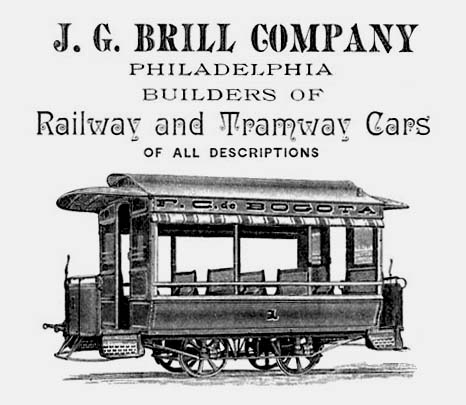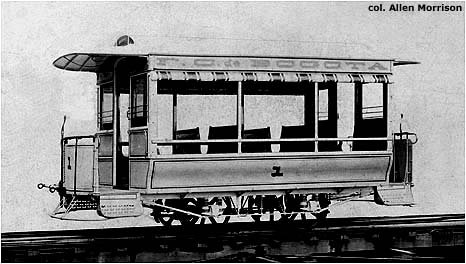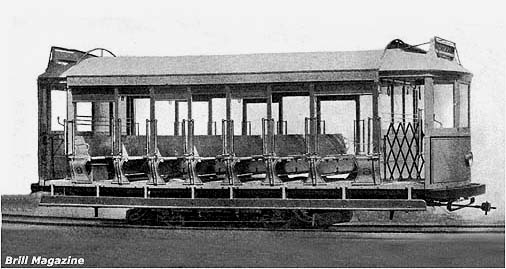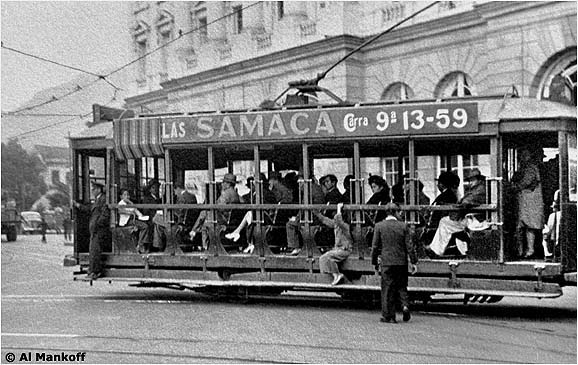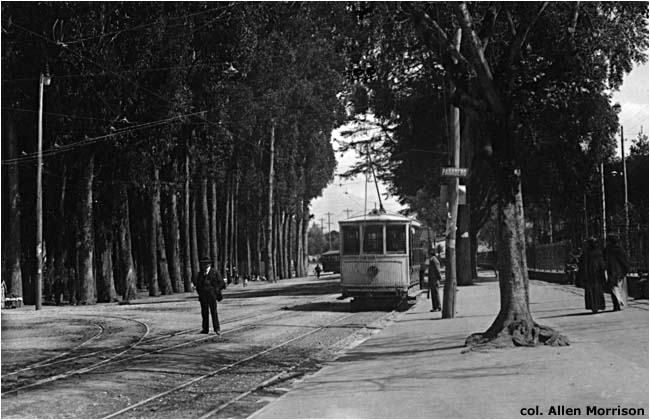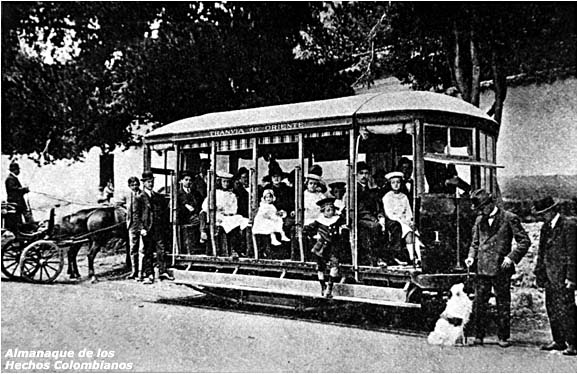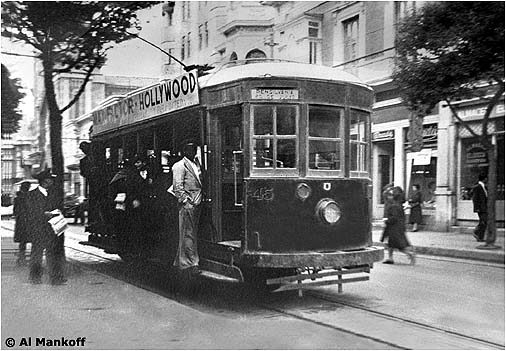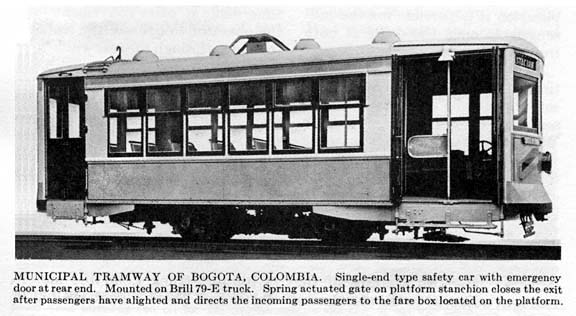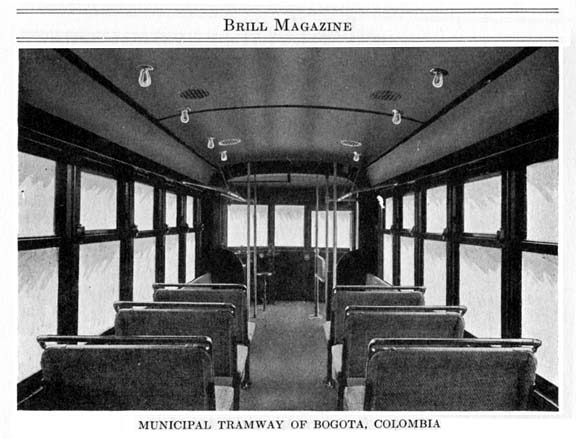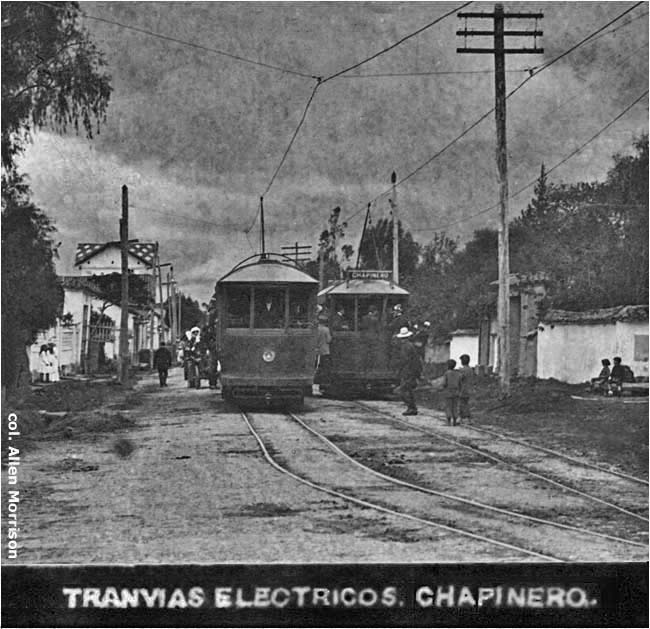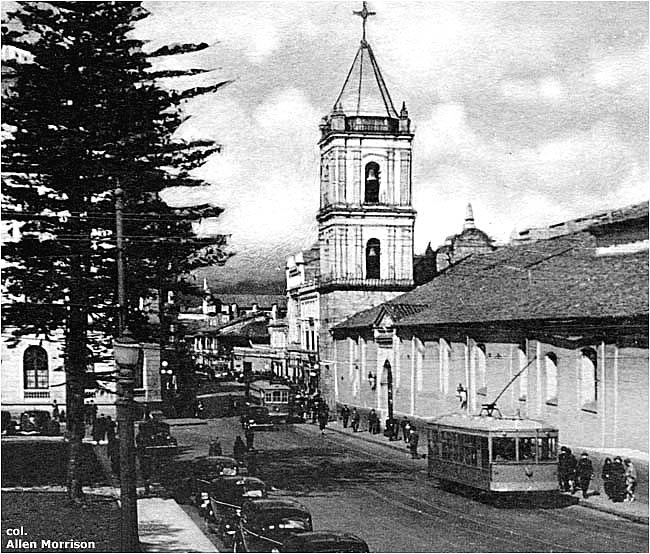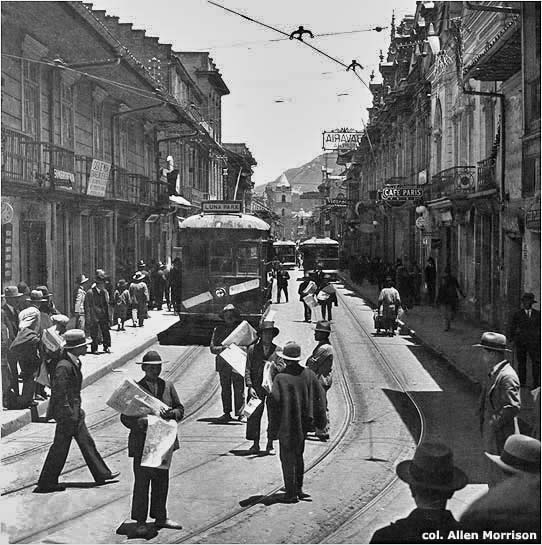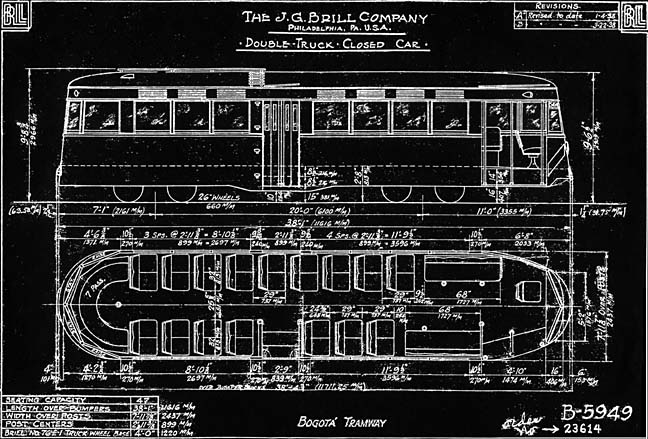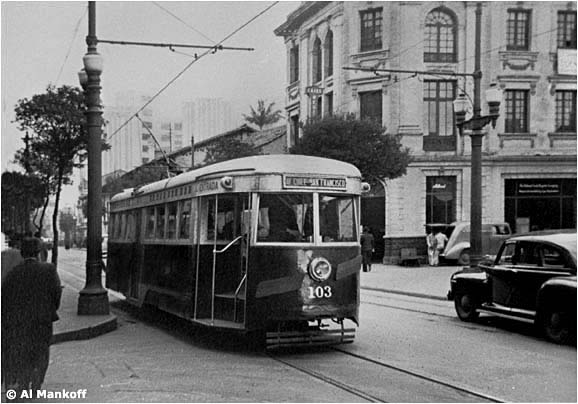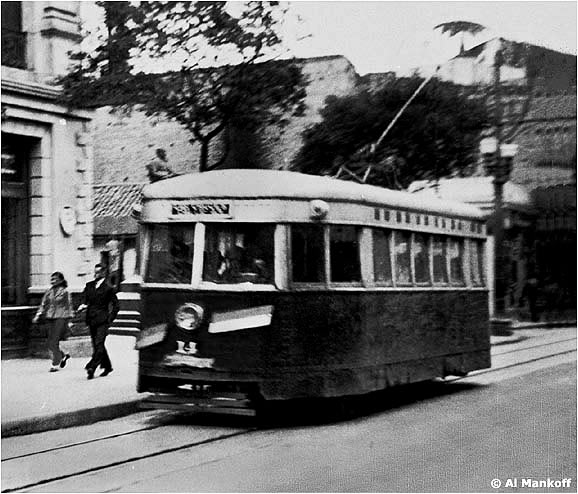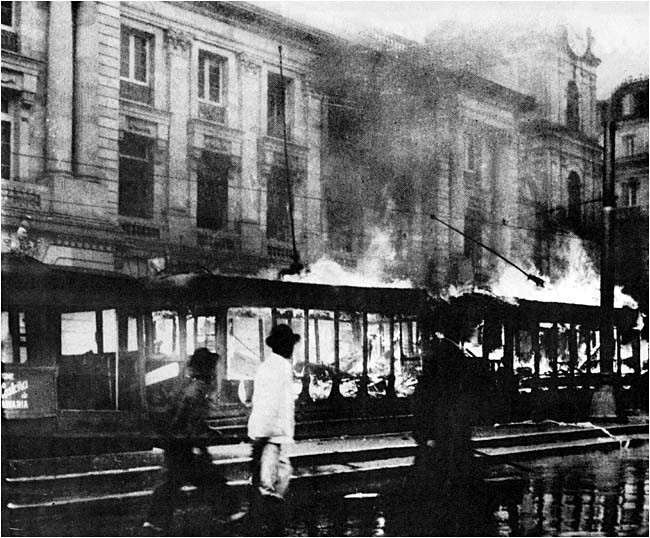South America's fifth-largest city (after São Paulo, Buenos Aires, Rio de Janeiro and Lima) sprawls across a plain at altitude 2,610 m (8,563 ft). The Andes rise to 3,300 m (10,827 ft) on the city's east side [see map]. Bogotá is the continent's third-highest capital (after La Paz and Quito). Its population was about 100,000 in 1900, was about 700,000 in 1950, and is about eight million today. The development of transportation in Colombia was complicated by its rugged, mountainous terrain. Bogotá was not reached by steam railroad until 1889 and did not have rail access to a navigable river until 1909. Both its first horsecars, built in 1884, and its first electric trams, imported in 1908, had to be disassembled and transported up the slopes on the backs of mules. Bogotá's first rail transport was a horsecar line that opened in 1884. A group of U.S. businessmen secured permission to operate in Colombia and founded the Bogotá City Railway Co. in New York on 30 October 1883. On 13 January 1884 they ordered 16 two-axle trams from J. G. Brill Co. in Philadelphia: eight closed cars, numbered 1-8, and eight open cars, numbered 9-16. The company was called Ferrocarril de Bogotá in Colombia, as shown in the advertisement below [col. AM]:
The original Brill photograph on which the drawing above was based (the photograph was purchased recently on eBay by Norwegian collector Roy Budmiger, who gave it to the author) [col. AM]:
Bogotá City Railway a.k.a. Ferrocarril de Bogotá inaugurated streetcar service on 1 December 1884: from Parque de Santander up Carrera 7 to Calle 26, then along Carrera 13 to Calle 67 in the Chapinero district [see map]. The tramway depot was at Calle 57. BCR extended the line soon after to Plaza de Bolívar, which is shown in this undated photograph. Note both open and closed trams [col. Claudio Bellon]:
An unusual aspect of the Bogotá tramway was its use of meter gauge, which was unknown in the United States and not used elsewhere in Colombia until Ferrocarril de la Sabana, a steam railroad, opened its first line in 1889. Most of the railroads and tramways in Colombia used 914 mm / 3 ft gauge. In 1890 Brill sent the Bogotá tramway three freight cars and 16 new trucks for its passenger cars. BCR relaid its rails in 1894. Colombia's first electric tramway was technically a line that a British firm built in 1893 in Panama City, Panama, then a department of Colombia. But that line closed in 1898 and Panama seceded from the republic in 1903. (Panama City built another electric tramway in 1913.) U.S. involvement in Panama's secession and the creation of the Canal Zone produced a wave of anti-Americanism in Colombia that lasted many years. After an electric tramway opened in 1907 in Caracas, capital of next-door Venezuela, BCR began electrification of the Chapinero line in Bogotá. Meter gauge was maintained and a new depot was constructed on Calle 26 [see map]. On 21 August 1907 BCR sent J. G. Brill an order for six 8-bench electric trams, to be numbered 1 to 6. Here is a photograph of one of them, taken at the Brill factory in Philadelphia before it left for Bogotá [Brill Magazine, Philadelphia, 2/1910, p. 54]:
Like its horsecars, Bogotá's first electric trams were transported in pieces from sea level to altitude 2,610 m (8,563 ft) on the backs of mules. The new vehicles arrived in Bogotá in early 1908, but did not go into operation for over two years. Construction of the electric line was delayed and horsetrams were still running to Chapinero in 1910 [see map]. Tram service had deteriorated and hostility against the American-owned company increased. On 7 March 1910 a small boy tried to ride a tram without paying a fare. The driver pushed him off and hit him. A crowd gathered, police arrived and a BCR official narrowly escaped with his life. The tramway system shut down for a week. It reopened on 16 March, but the public would not ride the cars. BCR kept the line closed for four months, finally placed a few of its new electric cars in service on 20 July, Colombia's Independence Day. But the boycott continued. On 1 September 1910 the New York businessmen sold the tramway to the city, which formed the new Tranvía Municipal de Bogotá (TMB). The Colombians established full revenue service in October. The photograph below, taken in 1946, shows one of the original open cars of 1908 [Al Mankoff]:
TMB improved tramway service and expanded the system: new rails were laid south on Carrera 7 to Las Cruces, west on Calles 10 and 15 to the railroad station at Paiba, up Carrera 13 and over Calle 26 to the cemetery [see map]. In 1915 it ordered five more 8-bench trams from Brill, another eight in 1916. Its electric cars were now numbered 1-19. The postcard view below shows an unidentified tram on Carrera 7 [col. AM]:
TMB was not the only operator of electric trams in Bogotá. A company called Ferrocarril de Oriente secured a franchise in 1916 to build a meter-gauge railway along Carrera 13 from Puente Núñez to Yomasa, 14 km southwest of the city [see map]. Construction began in 1917, but delivery of the locomotives was delayed so FO provided a tram service along the first 3 km of the line, from Puente Restrepo to Calle 10, then along TMB tracks (with its permission) to Plaza de Bolívar. FO formed a subsidiary, Tranvía de Oriente, and ordered a battery-powered tram from J. G. Brill on 6 December 1917. The carro eléctrico de acumuladores started running between Puente Restrepo and Plaza de Bolívar, a distance of 4 km, on 14 April 1918 [see map]. The batteries were under the seats [Almanaque de los Hechos Colombianos: see BIBLIOGRAPHY]:
TMB later rescinded TOB's privilege and the battery tram terminated at the corner of Carrera 13 and Calle 10 [see map]. FO's yards and the terminus of the steam line were at Puente Núñez, Carrera 13 and Calle 6. In the 1910s TMB extended its Paiba line west to Ricaurte and its Las Cruces line south to San Cristóbal. It also built a new line down Carrera 10 to Av. 1 (Primera), which was later extended to Luna Park and Santander. During those war years it also built 20 open trams in its shops. The postcard view below shows a 6-bench model [col. AM]:
The home-made cars were not satisfactory and TMB resumed imports in 1919. On 8 April of that year it ordered six 8-bench open cars from St. Louis Car Co. in the United States – its only purchase of non-Brill equipment. This photograph of St. Louis tram 45 on Carrera 7 [see map] was taken in 1946 [Al Mankoff]:
In 1921 TMB purchased its first closed "Birney" cars from Brill, which were called nemesias in Bogotá after the company's manager, Nemesio Camacho [Brill Magazine, 9/1927, p. 59: see BIBLIOGRAPHY]:
Interior of the car above [Brill Magazine]:
TMB ran its last horsecar in 1921 and extended the Chapinero line north on Carrera 13, then east on Calle 72 [see map]. Trams never ran on Carrera 14, the city's main north-south thoroughfare today, for that path was occupied until the 1930s by the Ferrocarril del Norte. The undated postcard view below appears to show the Chapinero terminus [col. AM]:
Here are two nemesias on Calle 72, also known as Av. Chile [col. AM]:
A postcard view of Carrera 7 in the 1930s [see map] [col. AM]:
The photograph below, taken in 1946, shows a nemesia escorting traffic along Carrera 7, near the city center [see map] [Al Mankoff]:
The colored stripes on the fronts and rears of the cars were intended to identify the route. The system was obviously impractical and the stripes were ignored after a while. Between 1921 and 1927 Brill supplied 14 nemesias to Bogotá and materials and parts for 19 cars that TMB assembled in its shops. TMB fleet numbers reached 75 [Al Mankoff]:
Larger trams were needed as ridership increased. In 1928 TMB ordered its first double-truck model from Brill: ten 12-bench cars numbered 76-85. This picture of tram 76 was taken at the Brill plant in Philadelphia before it left the U.S. Note Brill builder's plate lower right [col. AM]:
TMB ordered another dozen 12-bench trams in 1934, numbered 86-97. The 1937 Supplement to the World Survey of Foreign Railways [see BIBLIOGRAPHY] reported 75 electric trams operating on 51 km of meter-gauge track in Bogotá. The photographer who took the postcard view below was looking north up Carrera 7 from Plaza de Bolívar [see map]. The tram signed "Luna Park" is unidentified [col. AM]:
An 8-wheel 12-bench open tram on Carrera 7 in 1946 [Al Mankoff]:
On 11 August 1937, preparing for the city's 400th anniversary the following year, TMB placed an order with Brill for eight trams of an entirely new design: a single-end, center-door, streamlined model unlike anything that Brill had built before (but which somewhat resembled the "Bullet car" that it designed for Philadelphia & Western in 1931 and the "PCC car" developed by St. Louis and other companies in the mid-1930s.) Here is the official drawing [col. AM]:
The new silver-roofed streamliners, numbered 101-108, entered service in April 1938 and were nicknamed Lorencitas by Bogotanos – after the wife of the Colombian president who had silver hair. Lorencita 103 was photographed on Carrera 7 in 1946 [see map] [Al Mankoff]:
Two years later, evidently using parts from retired vehicles, TMB constructed another half-dozen Lorencitas in its shops, which it numbered 109-114. This one was photographed in 1948 [Gustavo Arias]:
An undated view of homemade Lorencita 110 [col. Museo de Bogotá]:
The other side of a Lorencita in 1946 [Al Mankoff]:
With pieces of old nemesias or other single-truck cars, TMB built at least two 4-wheel streamliners, numbers 14 and 36, which the locals called Lorencitas chiquitas (little Lorencitas). This blurred but rare view of tram 14 was taken on Carrera 7 [see map] in 1946 [Al Mankoff]:
In 1947 TMB purchased 20 trolleybuses from CCF-Brill which it placed in service on Calle 26 in early 1948 (see The Trolleybuses of Bogotá). At the Conference of American Countries held in Bogotá on 9 April 1948 (and attended, it was learned years later, by a young Fidel Castro), the chief of the Liberal Party, Jorge Gaitán, was assassinated. In the following hours a mob ravaged the city, killed approximately 3,000 people, set fire to 136 buildings and destroyed 28 trams, 1/4 of the TMB fleet [col. AM]:
The tramway system was not eliminated by the Bogotazo, but its spirit was broken. The city's population was increasing rapidly and Carrera 7, the principal north-south tramway thoroughfare, was narrow and congested. The tram lines on other streets were single track with passing sidings. Rather than rebuild the tramway system, Mayor Fernando Mazuera Villegas replaced the rail vehicles with trolleybuses. Bogotá's last tram ran on the Pensilvania line [see map] on 30 June 1951.
BIBLIOGRAPHY "Foreign Facts" in Street Railway Review (Chicago), 8/1893, p. 514. A short news item reports that "an electric railway has recently been put in commission at Santa Fe de Bogotá, Columbia [sic], South America." "First Electric Road for Colombia" in Electrical World (New York), 28/3/1908, p. 642. The first shipment of electric trams left New York for Bogotá last Saturday. From Cartagena the cars will be transported 15 miles by rail, then 400 miles by riverboat, then 100 miles by muleback, then another boat trip, then another journey on the backs of mules. "Riot Follows Attempt to Operate Electric Railway in Bogotá" in Electric Railway Journal (New York), 6/8/1910. Early resistance to Yankee imperialism. Honorable Junta del Tranvía Municipal. Plano de Bogotá: Proyecto de Tranvías Eléctricos. London, 1912. Large map shows existing electric lines and plans for new routes. Colombia. Ministerio de Hacienda, Dirección General de Estadística. Anuario Estadístico, 1915. Bogotá, 1917. "Tranvía Municipal de Bogotá" section briefly describes the five tramway lines then in service. Bogotá. Concejo Municipal. Mensaje del Presidente (Bogotá), 1919-1921, pp. 72-91; and 1921-1923, pp. 139-161. Extraordinary reports of street railway development. Photo of a tram "construido integramente en los talleres de la empresa". Alfredo Ortega (Díaz). Ferrocarriles Colombianos. Bogotá, 4 vols., 1920-1949. "Tranvía de Bogotá" chapter in vol. 26, part 2 (1923), pp. 654-655, describes development of the urban tramway, both horse and electric. "Ferrocarril de Oriente" chapter in vol. 47 (1932), pp. 254-260, recounts history of the suburban steam line, briefly mentions the battery tram. [Vol. 26, 1920 & 1923; vol. 47, 1932; vol. 80, 1949] Almanaque de los hechos colombianos 1920-1921. Bogotá, 1921. "Compañía de Desarrollo Urbano, Bogotá, Luna Park" chapter, p. 483, briefly describes the park's battery-powered tramcar. The photo of the car on p. 487 is reproduced above. "Cultura": Asociación Internacional para el Comercio y la Industria. Bogotá: El Plano del Estado de la Ciudad en Enero de 1923. Bogotá, 1923. Huge (2 ft x 4 ft) street map shows rail lines in detail, including Tranvía de Oriente. "Recent Car Shipments to Bogotá, Colombia" in Brill Magazine (Philadelphia), 9/1927, pp. 59-60. Detailed description and two illustrations (both reproduced on this page) of the Birney model. "Das Verkehrswesen in Kolumbien" in Verkehrstechnik (Berlin), 1929, pp. 468-469. Article about Colombian tramways includes a photo and maps of both the Bogotá and Medellín electric tramways. U.S. Bureau of Foreign & Domestic Commerce. Foreign Railway News (Washington), #270, 21/1/1930. "Bogotá (Colombia) Tramway System", p. 1. Nice description. U.S. Bureau of Foreign & Domestic Commerce. Survey of Foreign Railways. Washington, 1933 (Supplement, 1937). Gauge, route length, fleet description of Bogotá tramway. [Author not recorded.] Plano de Bogotá 1933. Beautifully-drawn street map at scale 1:20,000 shows tram lines and steam railroad line running north on what today is Carrera 14 or Avenida Caracas. Beatty, W. J. "Sistema de transportación urbana de Bogotá" in Ingeniería Internacional (New York), 12/1934, pp. 339-340, 356. Excellent survey of Bogotá tramway system. Detailed description of rolling stock. Four photographs. Santafé de Bogotá: Guía Ilustrada 1935. Bogotá, 1935. Length of each route of the "Tranvía Municipal". Rueda Vargas, Tomás. "El Boycoteo al Tranvía en 1910" in Registro Municipal (Bogotá), 31/3/1937, pp. 139-141. Good account of the 1910 streetcar riots. "Street Cars for Export: Eight vehicles built by Brill for use in South American city" in Transit Journal News (New York), 2/4/1938. Description and photograph of Lorencita number 101. "Un Desfile Demostrativo del Progreso del Tranvía" in El Tiempo (Bogotá), 2/8/1938. Full-page article about a tramway parade. Photographs of a horsecar and a new Lorencita. Bogotá. Tranvía Municipal de Bogotá, 1940. Large street map shows tram lines. "Explicación de los Recorridos" in margin notes the franjas (colored stripes) and describes each route in detail. Karl H. Brunner. Manual de Urbanismo. Bogotá, 1940. "La disposición de los tranvías", pp. 291-293. Plans for development of the tramway system. Bogotá. Registro Municipal (Bogotá), 30/9/1941, pp. 545-546. Data on the tramway system. Plans for trolleybuses. Plano de Zonificación de Bogotá, Aprobado por el Acuerdo 21 de 1944. Bogotá, 1944. Superb large street map shows tramway system in detail. U.S. International Trade Office. Industrial Reference Service. Vol. 4, Part 1, No. 2. Washington, 1946. Five paragraphs of data on the "Bogotá Street Railway". Bogotá. Secretaria de Obras Públicas Municipales - Departamento de Urbanismo y Proyectos. Bogotá - 1947. Bogotá, 1947. Large street map, scale 1:25,000, shows tram same tram lines as 1944 map above. This must be system at its maximum extent. Martínez Cabana, Carlos. “Los Grandes Viajes: Bogotá-Chapinero” in Cromos (Bogotá), 3/5/1947, pp. 2-5. Wonderful tram lore. Twelve tram photographs! Bogotá. Registro Municipal (Bogotá). "Informe sobre el Tranvía Municipal", 14/11/1947, pp. 560-561; 17/3/1948, pp. 84-85. Streetcar report, trolleybus plans. Caro, Eduardo. Bogotá 1947. Bogotá, 1947. Nice map of maximum streetcar system before the 1948 riots. Bogotá. Departamento de Estadística e Investigación Social. Anuario Municipal de Estadística, 1948, 1949 and 1950. “Tranvía Municipal” statistics, by route. "Suprimidos los Ultimos Tranvías que Estaban Prestando Servicio" in El Tiempo (Bogotá), 1/7/1951, pp. 1 & 7. The last tram on the Pensilvania–20 de Julio line closes the tramway system. "Ha Muerto el Tranvía, Viva el Bus" in El Tiempo (Bogotá), 2/7/1951, p. 5. Typical anit-tram thoughts, then reflection on what has been lost. Colombia. Ministerio de Obras Públicas y Transporte. Ferrocarriles Nacionales de Colombia. Bogotá,1977. "Tranvía de Oriente de Bogotá", p. 76, recounts history of the suburban line. Aprile Griset, Jacques. El Impacto del 9 de Abril sobre el Centro de Bogotá. Bogotá, 1983. “Un Tranvía Llamado Estorbo,” pp. 83-103, presents complete streetcar history, with emphasis on the 1948 riots. Gustavo Arias de Greiff. La mula de hierro. Bogotá, 1986. Superb illustrated history of Colombia's railroads. Text, maps, charts, hundreds of illustrations, including reproductions of color paintings. El 9 de Abril en Fotos. Bogotá, 1986. Album of photographs of the 1948 riot. Several show burning trams. Juan Mosca. Bogotá: Ayer, Hoy y Mañana. Bogotá, 1987. "El Fin de los tranvías", pp. 179-180. Tramway history. Photograph of burning trams. Nice picture of a Lorencita, p. 99. "Hoy en nuestra historia" in El Colombiano (Bogotá), 9/8/1995. Newspaper chronology says that on that date (9 August) 1902 Bogotá inaugurated its electric tramway, property of the Bogotá Electric Railway Co." The announcement is a mystery, for it is 99.9% certain that this did not happen. Sady González. Bogotá, Años 40. Bogotá, [1999]. Wonderful, large-format album of photographs from the 1940s. Eleven huge pictures of trams – including one double-page spread. Alberto Escovar W. Atlas histórico de Bogotá: 1538-1910. Bogotá, 2004. Fine descriptions of the Tranvía de mulas, p. 297, and The Bogotá City Railway Company, pp. 300-301. Large map. Excellent but small illustrations. Museo Vintage. Historia del Transporte Público en Bogotá. Elaborate 19-page website with photos and brief history of the city's transport system. Buses de Colombia. Transporte Urbano en Bogotá: Tranvía. Nice 4-page tramway history, with many illustrations. Historia de Chapinero. Multi-page history of the Bogotá suburb has several paragraphs about the tramway. Paul Wolf. The Bogotazo. Excellent English-language page shows three photos of damaged or burning trams. FotografIas con historia: El Bogotazo: 9 de abril de 1948. Several photographs show burning trams. Alberto Martínez. Tranvía de Bogotá. Elaborate website about the restoration of horsecar number 9 from 1884. Text and many photos, both of old Bogotá horsecars and of the restoration process.
Also see and If you have comments, criticism or suggestions, This site was placed online on Copyright © 2007-2107 Allen Morrison |
